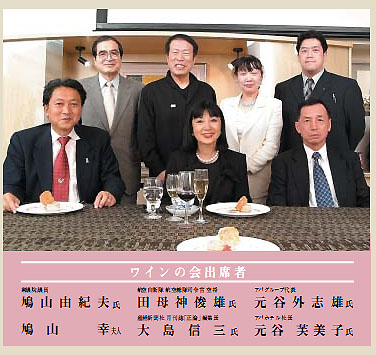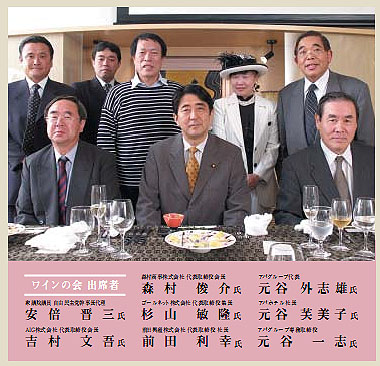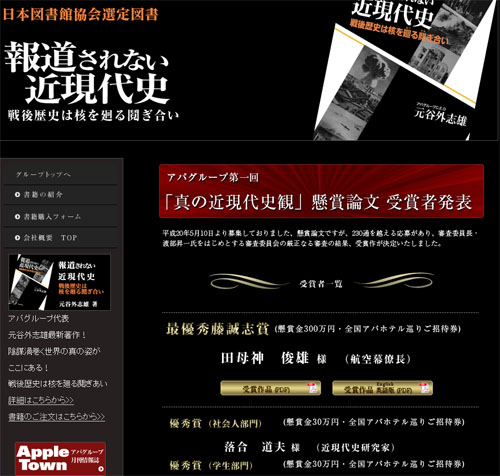Note: I have followed up this post on November 21st, and then again on December 1st.
The publication of an essay denying Japanese aggression in the Pacific before and throughout the WW2 by Japan Air Self-Defense Force Chief of Staff Gen. Tamogami Toshio (pictured below) could have led to another major international diplomatic incident. This seems to have been curtailed by his immediate firing, and a reaffirmation of the Government of Japan’s official stance of acknowledging Japanese aggression.

The essay was published on the website of APA Group, a large construction and real estate conglomerate best known for scandals involving inadequate earthquake proofing and falsification of records, as the grand prize winner of an “essay contest.” (The essay can be found on the award page, in both Japanese and English. Oddly, none of the lesser prize-winning essays are available.)
Almost all of the news coverage I have seen reports simply on the contents of General Tamogami’s essay, the fact that it was a contest, his prompt dismissal, and some half-hearted complaints about the essay from overseas (clearly headed off by the rapidity of his firing), but aside from this article at Mainichi virtually nothing about the contest itself. My first reaction was to wonder what the background story here was.
Naturally I started poking about online. I’ll start with what the Mainichi story had to say about the contest:
Watanabe etc. on the selection committee
According to the APA Group web page, essays were solicited for the purpose of “steering Japan towards a correct understanding of history as an independent nation”, and a prize of ¥3 million (Note: around $30,000 USD) was awarded as the grand prize. The head of the selection committee was Sophia University Distinguished Professor Watanabe Shouichi, a conservative commentator. APA Group CEO, Motoya Toshio, writes essays on historical perceptions under the pen name Fuji Seiji (藤誠志).
Mr. Motoya does not simply write essays under this pen-name, but actually publishes them in the APA corporate newsletter, Apple Town (“Fresh Information For Your Best Life”). He has also published a number of books under his own name, which you can order through the APA website, most notable “Modern History The Media Doesn’t Report on: Postwar History is an Argument over Nuclear Weapons”, for which he has a promo page on the APA site. (There are also a couple of books written by his wife, Motoya Fumiko CEO of APA Hotels.) Incidentally, another of Mr. Motoya’s books, “Business is Romance”, appears on a “Japanese National Bibliography” page on the National Diet Library website.
As you can see from the above screen capture of the contest website, the essay contest actually appears to be a promotion for his book. In fact, the grand prize is self-aggrandizingly named the “Fuji Seiji Prize Award”, after Mr. Motoya’s pen name. Although APA Group is a publicly traded company and not a family business (I believe this is the case, but I am not 100% sure, so I would appreciate someone checking), CEO Motoya is not only using the corporate website and magazine to promote his right-wing political agenda, but may also very well be using corporate funds for the contest prize money. According to this blog post, the book is also being promoted and sold in APA hotels.
At or near the bottom of the sidebar present throughout the entire APA Group website (some pages have other links below), there is also a link to an external political organization run by Motoya, the “Kanazawa Friends of the Komatsu Military Base.” (小松基地金沢友の会) The purpose of the group, according to a statement from Motoya on the front page is “get the entire citizenry of Japan, in which there is yet a shallow understanding of the importance of national defense, to understand that a balance of power involving military deterrent leads to international peace,” and to “support the Komatsu Base, which covers the entire Sea of Japan region, which is close to such countries as Russia, China and North Korea.” Googling a few sample names from the members list produces what would be expected: old men from Ishikawa Prefecture involved mostly in business, and one LDP Diet member who had held a minor position in Koizumi’s cabinet.
The website is located on a domain which appears to be independent of APA Group, at jasdfmate.gr.jp (Japan Air Self Defense Force Mate at the Japanese secondary .gr domain for volunteer groups). They also appear to be hosted at different locations, as the traceroute path is significantly different. However, the WHOIS database indicates that the contact person for both websites is a Nishikawa Harumi (西川 治美), who according to the apa.co.jp WHOIS entry is an employee in the Business Section of APA Co.,LTD. and according to the jasdfmate.gr.jp WHOIS entry is a “Clerk” for “Air Self-Defense Force in Komatsu, Kanazawa Mate.” Ms. Nishikawa has been listed as the contact person for the sites since at least 2001.01.16 and 2000.03.21 respectively, when the contact information was last updated. The shallow attempt at separation of private form corporate breaks down, however, when the JASDFMate site lists the contact email address as office@apa.co.jp. You too can join the group, and go on their various activities-such as tours of the base-for a mere ¥10,000.
“Modern History The Media Doesn’t Report on” was published on April 18 of this year, and a combination publishing celebration party and birthday party was held in early June, which is commemorated at this page on the APA site. This page contains some videos which were screened at the party, the third of which finishes off with a list of the party’s sponsors. The list is long, but contains quite a few names of note. Some of the ones that jumped out at me were (in order of appearance):
- Asao Keiichiro (DPJ Shadow Defense Minister)
- Abe Shinzo (former LDP PM)
- Ikeguchi Ekan (Shingon-shu leader)
- Koh Se-kai (Former Taiwan representative to Japan, Taiwan independence activist)
- Ko Bunyu (Japan-resident Taiwanese independence activist and writer, darling of Japan’s far right)
- Dewi Sukarno (Japan-born former wife of Indonesian dictator Sukarno)
- Tamogami Toshio (just-fired JASDF chief)
- Hatoyama Kunio (LDP politician, currently Minister of Internal Affairs and Communications)
- Bobby Valentine (Former MLB baseball player and manager, current manager of Japan’s Chiba Lotte Marines baseball team)
- Jose de Venecia, Jr. (Speaker of the House of the Philippines)
- Mori Yoshirou (Former LDP PM)
- Watanabe Shouichi (Sophia U. Distinguished Professor of English and right-wing commentator, and head of the essay committee)
According to this Sankei article on the party, over 1500 guests were in attendance, of which several dozen were thanked by name in the video.
In this photo of the party (again, from the APA page) you can see General Tamogami was not merely a guest at the event, but actually addressing the crowd. This was just under a month after the contest had been announced, on May 10. According to the above-linked Sankei article, Tamogami jokingly referred to himself as a “controversial figure” and said that:
After the war, speech arguing to defend our country was suppressed, but speech that was anti-Japan or badmouthing Japan was free. As long as the fundamental problems of security are not dealt with, it is impossible to be ready to protect this country in the manner it deserves.
This is a reference to constitutional revision to eliminate or revise Article 9-Japan’s famous pacifism clause. Essentially, the grand prize winner of an “essay contest” was a speaker at an event which was both the launch party for the book the essay contest was promoting, as well as the birthday of the author, expressing essentially the same opinion later given in that essay.
Tamogami and Motoya actually had a political association dating back some time, at least to a “Wine no Kai” (Wine Party for Discussing Japan)documented in Motoya / APA’s own magazine. (Click here for PDF of the article, originally copied from the APA web site.) In this photograph you can see Tamogami , Motoya, Hatoyama Yukio (one of the leading hawks in Japan’s opposition Democratic Party, which differs little from the permanent ruling LDP on substantial matters, his family name ironically means “Dove Mountain”) and his wife, as well as Sankei Journalist Oshima Shinzo.

I am actually slightly unclear whether the article text is a summary of the discussions had at the party or simply yet another of Motoya’s essays, but it is probable that the participants at least agreed with the ghist of it. The article concludes by stating that “the statement that ‘Japan must absolutely not equip itself with nuclear weapons’ is absurd.” Japanese nuclear armament seems to be one of Motoya’s main issues.
Motoya has apparently hosted a number of annual sessions of the “Wine no Kai,” including a session the following year attended by not-yet Prime Minister Abe Shinzo.

That’s Abe sitting there in the middle, flanked by Motoya Toshio, with the horrific grimace and weirdly out of place striped shirt, and Mrs. Motoya Fumiko, wearing one of the silly hats she is famous for. PDF of the entire article is here.The article contains nothing nearly as inflammatory as the previous year’s call for nuclear weapons, but I would like to share this brief and bewildering excerpt.
A certain Japan-born Korean said that “The Japanese value respect. Japanese culture is excellent on the inside. But I shed tears when looking at today’s Japan.” The lazy attitude of young people is particularly offensive. Korea still has a military draft system, and although I am not saying that Japan should revive militarism, I will say that the draft system should be introduced. They would not need to serve for two years, but let them live for a year in a group to teach them rules and endurance. If you invite a young person today to say “let’s go drinking” they refuse saying, “that’s OK.” In the old days, they were happy to get an invitation from an elder.
Abe and Motoya are reputed to have far stronger links. Although it seems to have been rarely discussed in the mainstream media (keep in mind that Japanese newspapers keep articles online for a very short time and I am not actually going so far as to check archives), it has been repeatedly claimed on blogs (most notably Kikko’s Diary, but also many smaller ones) that Motoya was vice-chair of Abe’s political support committee known as the Anshinkai, (安晋会, J-Wikipedia article). The name “Anshin” is a pun derived from part of Abe Shinzo’s name, which also sounds like the Japanese word for “safety.” neither the existence of Anshinkai nor Motoya’s membership in it has ever been publically acknowledged, but the above photograph of the “Wine no Kai” is often cited as evidence of both.
One blog wrote in February 2, 2007, that “mentions of Anshinkai have finally started appearing off-line as well,” indicating that this story actually began in the blogs before being taken up by the offline media, in a pattern considered to be generally un-Japanese. Another blog, on the same day, has a roundup of weekly news magazines (traditionally these magazines and not daily papers is the place for news that is more based on investigation or rumor) which had recently mentioned the Anshinkai, including Shukan Post, Shukan Bunshun and Shukan Asahi. The blog says that Shukan Post had been the first to report on Anshinkai, in February 10, 2006, alleging a connection with the Livedoor scandal.
Another blog, from January 31, 2006, has some more information on the Livedoor connection, notably that HS Securities VP Noguchi Hideaki, who committed suicide after falling under suspicion, was director of Anshinkai. The same article contains a dizzying chart of connections between various persons, groups and companies, which does not include Motoya/APA but does include another interesting name – HUSER (Human User Company). Huser had been involved in a construction inspection scandal, seriously enough so that President Ojima Susumu was actually called to testify before the Diet, where he admitted to meeting with Abe Policy Secretary, Iizuka Hiroshi.
As I mentioned at the beginning of this increasingly long post, APA Group is now infamous for their involvement with a similar scandal. I don’t want to spend more time on this, so I recommend you read the good English coverage of at Shin Fukushige’s blog (note that Adam commented on this post.) The CEOs of both Huser and APA are allegedly members of Anshinkai, and there has much much suspicion that Abe and his people deflected as much heat as he could. The connections between Motoya and Abe are strong enough that Kikko titled one January 2007 post “APA Group is Abe Group.”
As I write this, the US 2008 election results are coming in and I want to wrap this up so I can concentrate on that, so let me summarize briefly.
Motoya Toshio is a very successful construction and real estate entrepeneur, with extreme right wing views, an obsession with political leaders and celebrities (he brags about having met a wide variety of famous people, starting oddly with Castro), and an otaku-esque fascination with military things (he also brags about having taken a test flight on a fighter plane). Having built his company into the massive APA Group, he used his company’s publicity apparatus to promote his political ideas, and his significant financial leverage to support Japanese politicians supportive of his militaristic agenda. He appears to have also used those political connections to promote large business projects, and when his company became embroiled in a serious construction inspection scandal, he also turned to his political allies for help.
Combining his attraction to both power and military, he invited ASDF General Tamogami Toshio into his circle, bringing him to the Wine no Kai and to address the launch party for his latest right-wing tract. Motoya then had APA sponsor an essay contest promoting his book-possibly an illicit use of corporate funds-with the grand prize awarded to Tamogami , in a decision I suspect was actually arranged by Motoya personally, with the “selection committee” only choosing the lesser prizes. Motoya was probably hoping that Tamogami , who had a history of making controversial public statements and escaping serious censure, would be able to step up and continue the main-streaming of right-wing militaristic views, but his gamble failed. His friend Abe Shinzo was no longer Prime Minister, having perhaps spent too much of his political capital defending Motoya’s APA Group and Huser during the earthquake proofing inspection scandals, and Aso’s government was just not interested in risking blow-back by defending a general who had so egregiously violated the rules on political speech by uniformed officers and the supremacy of civilian leadership. Fukuda Yasuo had worked to improve relations with China and other neighbors following the Abe administration, and perhaps newly appointed Prime Minster Aso Taro, despite his right-wing views and his own well-earned reputation for making gaffes decided to take the pragmatic route and declined to protect Tamogami .




 As it so happens, just last week I picked up
As it so happens, just last week I picked up